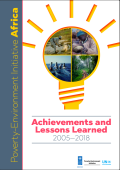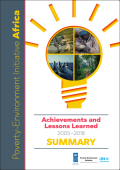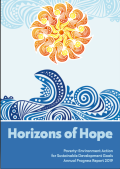
This report reviews the Initiative’s successes and failures, and its responses to these. It documents how robust and integrated evidence—along with changes in policy, budgeting, investment and monitoring frameworks and involving a diverse set of actors—has begun to shape the institutions needed to achieve the Sustainable Development Goals (SDGs).

The story told in the pages is one of reaping the rewards of this multi-year, complex effort to mainstream poverty, environment, climate, gender and equity into the heart of government. Results have been achieved through the provision of an integrated approach to mainstreaming the poverty-environment nexus in 24 national and 4,214 local development plans for 17 countries, 93 sector strategies in 13 countries, 84 budget processes in 10 countries and 56 monitoring and evaluation systems in 12 countries.

This summary report highlights the Initiative’s successes and failures, and its responses to these. It documents how robust and integrated evidence—along with changes in policy, budgeting, investment, and monitoring frameworks and involving a diverse set of actors—has begun to shape the institutions needed to achieve the Sustainable Development Goals (SDGs). The report offers a set of recommendations on how to achieve policy, budget, and expenditure coherence for sustainable development using country-owned planning frameworks, new knowledge and tools, and building national capacities.
Strategic Plan 2021-2031 for a Cleaner Solomon Islands by Enhancing the Private Sector Participation

This publication presents the 2021-2031 strategic plan of the Solomon Islands Recyclers and Waste Management Association, focusing on the overall vision of achieving a cleaner country through the active participation from private sector entities on waste management.

This report covers progress on the implementation of UNDP–UNEP Poverty-Environment Action for Sustainable Development Goals through seven full-fledged country projects, as well as two technical assistance projects, underway in 2019. It gives an overview on the project’s performance using established baselines, indicators and targets at the global and country levels, and provides lessons learned during the first full year of implementation.
